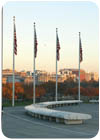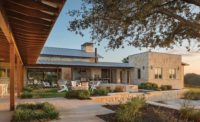
Olin Partnership of Philadelphia, PA, was challenged to revamp the grounds of the Washington Monument by removing temporary security measures and adding a range of new stonework. To meet the request by the National Park Service, the architects designed a 3-foot-tall granite wall with constraining entry points, which serves as the main focal point on site. Landscape Architect: Olin Partnership of Philadelphia, PA; Stone Suppliers: Polycor Inc., Canada (granite); Polycor Georgia Marble, Tate, GA (marble); Stone Installer: Lorten Contracting, Springfield, VA

The pedestrian pathways also feature Blue Grey granite, which works well with the overall color palette, according to E. Allan Spulecki, Associate and Project Manager with Olin Partnership.
According to E. Allan Spulecki,Associate and Project Manager with Olin Partnership of Philadelphia, PA, the main objective of the landscape project was to improve security on site. To meet this request, the architects constructed a low 3-foot-tall granite wall with constraining entry points to prevent a person from firing a shot from a passing vehicle. “We integrated the landscape with the security aspect, while still providing a pleasant atmosphere,†said the architect, adding that the wall serves as a focal point on the grounds.
The 3,200-lineal-foot radial perimeter wall features rock-face finished Blue Grey granite on the facing and a 6-inch-thick solid coping of Blue Grey with a thermal finish at the perimeter wall. In addition, the wall contains an extended curb comprised of 10-inch-thick pieces of Cambrian Black granite. Spulecki said the wall was built over the existing landscape and formed as a natural barrier to blend into the site. “The granite wall has a real chiseled look to it, and was all hand carved,†said the architect. “The rock-pitched finish really brings out the color in the stone. The material was selected because it had the appropriate look and color for the site, as we didn't want anything too brown that would blend into the landscape.â€
Another main feature on the grounds is the plaza area, where restoration of previously installed granite and marble was required. Olin Partnership redesigned the prior paving pattern and expanded the plaza size from 50 feet to 75 feet. According to Gorica Sefer, an architect and Project Manager of Polycor, a total of 44,000 square feet of 3-inch-thick thermal radial and segmented pavers of Blue Grey granite and Cambrian Black granite were used at the plaza.
In addition, the architects added backless seat benches constructed out of Cherokee White marble from the Polycor Georgia Marble quarry in Tate, GA, which matches the material used for the monument itself. “We wanted the bench to be a part of the architectural site, and it is a very appropriate match for the Washington Monument grounds,†said Spulecki. “It is a large civic bench that was designed within the proportions of the monument. It is big and broad, and the character of the stone and colors are similar to the monument as well. The natural veining and character feature lines are the ideal match. The stones look like they are from the same family.â€
Furthermore, Olin Partnership custom designed another marble bench featuring Cherokee White marble, which rests near an old historic lodge structure that is currently used as a ticket booth and a visitor information center. For this area, they selected the same material that was employed for the plaza, but used it in a different design and a different scale, according to Spulecki. “The bench here has a back due to the contouring of the adjacent grade behind it,†he said. “It is a very modernly designed bench.â€
The pedestrian pathways also feature Blue Grey granite, which Spulecki said works well with the overall color palette. Additionally, Sefer added that the Blue Grey “communicates an emotion of simplicity with its natural look and creates a fabulous contrast with the noble white marble and the sophisticated curves on the benches.â€

In addition to granite features, benches constructed out of Cherokee White marble were also added, and the stone's look is similar to that of the actual monument.
Overcoming Obstacles
According to Spulecki, a few challenges arose while on site. “The major challenge was to design a wall to meet the requirements by the client to ensure their program for security improvement,†he said. In addition, he found it challenging to find the right color stone with the right finish. “Polycor helped us out by designing a few mock-ups,†said Spulecki, adding that he also had to convince the client of the quality and endurance of the stone.The geometry of the site also posed problems for the crew, as did the complexity of the design. “As simple as the project looks, there was still a lot of detail to how it was all put together - especially when trying to get the stone all cut right,†said the architect.
The National Park Service wanted to have the site open to visitors in time for Fourth of July 2005, making a timely schedule another obstacle for the workers. “The site was closed down for two years, and as of March 2005, the National Park Service opened a portion of the park, so construction had to work around that,†said Spulecki. “The stone fabricators had to finish part of the site from the southwest corner, which meant that their access was restricted to the opposite side of the site. This also posed logistical challenges as the crew had to work around the visitors in a safe and secure way while maintaining their proper monument security.â€
Despite the several challenges involved with the project, Spulecki said everyone is pleased with the outcome. “Just looking at the site is a testament to that,†he said. “Visitors can enjoy the monument in a new way and the landscaping looks complete now, which is appropriate to such an important monument in the city of Washington, DC.â€
Installing and Restoring the Stone
According to Manuel Seara, President of Lorton Contracting of Springfield, VA, installation of the stonework took an average of 10 workers almost a year to complete. When installing the paving in the plaza area, the crew was faced with the challenge of precisely lining up the 100 elements of the perimeter with the granite paving pattern. Seara said that there are a total of 50 flagpoles on site, one for each state, and in between them there are lights that help illuminate the monument. “All the paving meets the four corners of the monument,†said Seara. “Everyone assumed that the monument was perpendicular in alignment, but it turns out that is off center, so we had to make accommodations for that.â€In addition to installing new stone around the monument, Lorton Contracting also replaced and restored existing marble and granite in the lodge area. “We had to do some stone patching and some stone replacement at the lodge in order to match it to other historical elements,†said Seara. “This was part of the whole package in restoring the landscape around the Washington Monument. The lodge was built at the same time as the monument, and very little restoration work had been done to it over the years.â€
Seara added that the prestigious project recently received two awards for its fine craftsmanship - one from the Association of General Contractors and another from McGraw Hill. Renovations on the grounds of the monument began in 2002 and ended on schedule, in time for Fourth of July 2005.
